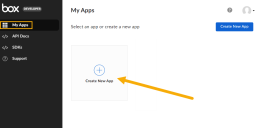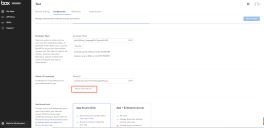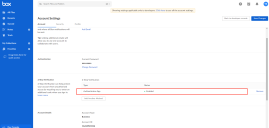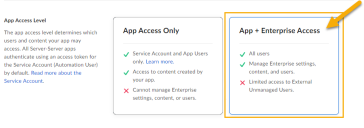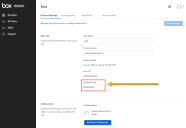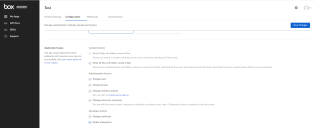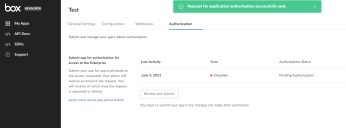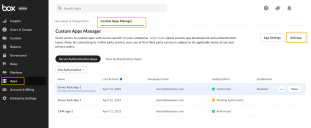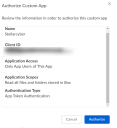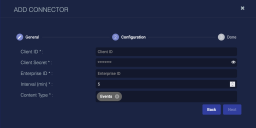Configuring Box Connectors
Connectors allow Stellar Cyber to collect data from external sources and add it to the data lake. There can be any number of Box connectors active.
Stellar Cyber connectors with the Collect function (collectors) may skip collecting some data when the ingestion volume is large, which potentially can lead to data loss. This can happen when the processing capacity of the collector is exceeded.
Connector Overview: Box
Capabilities
-
Collect: Yes
-
Respond: No
-
Native Alerts Mapped: No
-
Runs on: DP
-
Interval: Configurable
Collected Data
|
Content Type |
Index |
Locating Records |
|---|---|---|
|
Events |
Syslog |
Domain
|
https://api.box.com |
Response Actions
N/A
Third Party Native Alert Integration Details
N/A
Required Credentials
-
Client ID, Client Secret, Enterprise ID
Let us know if you find the above overview useful.
Adding a Box Connector
To add a Box connector:
- Use the Box Developer Console to set up a new Custom App for Stellar Cyber
- Use the Box Admin Console to authorize the new app
- Use the Box Admin Console to obtain the Enterprise ID
- Add the connector in Stellar Cyber
- Test the connector
- Verify ingestion
Use our example as a guideline, as you might be using a different software version.
Setting up New App in Box and Obtaining Client ID / Secret
Stellar Cyber must be added as a custom app in your Enterprise Box account. During this process you will need to make note of your Client ID and Client Secret.
-
Log in to the Box Developer Console with administrative privileges (http://app.box.com/developers/console). If you logged in to box.com instead, select Dev Console from the navigation pane.
-
Select the My Apps pane, and then click Create New App. Note that these instructions are based on creating a Custom App, not an Enterprise App.
The Custom App dialog opens.
-
Select the Server Authentication (Client Credentials Grant) option, supply an App Name, and click Create App.
-
The new Box application appears in the My Apps pane. Open it.
-
From the Configuration tab, copy the Client ID and save it to a temporary location for later use in the setup process (refer to the image in the next step).
-
Click the Fetch Client Secret button to retrieve the client secret. Save it to the same temporary location where you copied the Client ID.
Note that 2-Step Verification must be enabled for your account before you can use the Fetch Client Secret button. If it is not already enabled, you can turn it on on the Account Settings | Account tab, as illustrated below:
-
Ensure that App Access Level is set to App + Enterprise Access.
-
Click on the General Settings tab for your app and copy the Enterprise ID shown there to the same location where you stored the Client ID and Client Secret.
-
Click on the Configuration tab, scroll down to Application Scopes, and enable each of the options found there:
-
Navigate to the Authorization tab and click the Review and Submit button to send your request for application authorization to an Admin user.
- Exit the Box Developer Console.
Authorizing Stellar Cyber to Access the Box Account
Stellar Cyber must be authorized using the Client ID you obtained above.
Use the Box Admin Console to access your Box account.
-
Log in to your Box Admin Portal as an administrative user.
-
Select the menu option for Admin Console.
-
Select the Apps entry in the left navigation panel and click on the Custom Apps Manager tab.
-
Click the Add App button, enter the Client ID you created for Stellar Cyber application, and click Next.
-
Review the information in the dialog that appears and click Authorize.
-
Review the list of applications in the Custom Apps Manager and ensure your new application is displayed.
Obtaining the Box Enterprise ID
At this point, you have a Client Secret and Client ID. If you have not already noted the Enterprise ID for your Box account, use this procedure to obtain it.
-
Still logged into your Box Admin Portal as an administrative user with Enterprise access rights, select Account & Billing on the navigation menu.
-
Make note of the Enterprise ID listed in the displayed Account Information section.
Adding the Connector in Stellar Cyber
Now you are ready to add and configure the Box connector in Stellar Cyber:
-
Log in to Stellar Cyber.
-
Click System | Integration | Connectors. The Connector Overview appears.
-
Click Create. The General tab of the Add Connector screen appears. The information on this tab cannot be changed after you add the connector.
The asterisk (*) indicates a required field.
-
Choose SaaS from the Category drop-down.
-
Choose Box from the Type drop-down.
-
For this connector, the supported Function is Collect, which is enabled already.
-
Enter a Name.
Notes:- This field does not accept multibyte characters.
- It is recommended that you follow a naming convention such as tenantname-connectortype.
-
Choose a Tenant Name. The Interflow records created by this connector include this tenant name.
-
Choose the device on which to run the connector.
-
(Optional) When the Function is Collect, you can apply Log Filters. For information, see Managing Log Filters.

-
Click Next. The Configuration tab appears.
The asterisk (*) indicates a required field.
-
Enter the Client ID you noted above.
-
Enter the Client Secret you noted above.
-
Enter the Enterprise ID you noted above.
-
Choose the Interval (min). This is how often the logs are collected.
-
Choose the Content Type you would like to collect. The logs for Events are supported.
-
Click Next. The final confirmation tab appears.
-
Click Submit.
Testing the Connector
When you add (or edit) a connector, we recommend that you run a test to validate the connectivity parameters you entered. (The test validates only the authentication / connectivity; it does not validate data flow).
For connectors running on a sensor, Stellar Cyber recommends that you allow 30-60 seconds for new or modified configuration details to be propagated to the sensor before performing a test.
-
Click System | Integrations | Connectors. The Connector Overview appears.
-
Locate the connector that you added, or modified, or that you want to test.
-
Click Test at the right side of that row. The test runs immediately.
Note that you may run only one test at a time.
Stellar Cyber conducts a basic connectivity test for the connector and reports a success or failure result. A successful test indicates that you entered all of the connector information correctly.
To aid troubleshooting your connector, the dialog remains open until you explicitly close it by using the X button. If the test fails, you can select the button from the same row to review and correct issues.
The connector status is updated every five (5) minutes. A successful test clears the connector status, but if issues persist, the status reverts to failed after a minute.
Repeat the test as needed.
If the test fails, the common HTTP status error codes are as follows:
| HTTP Error Code | HTTP Standard Error Name | Explanation | Recommendation |
|---|---|---|---|
| 400 | Bad Request | This error occurs when there is an error in the connector configuration. |
Did you configure the connector correctly? |
| 401 | Unauthorized |
This error occurs when an authentication credential is invalid or when a user does not have sufficient privileges to access a specific API. |
Did you enter your credentials correctly? Are your credentials expired? Are your credentials entitled or licensed for that specific resource? |
| 403 | Forbidden | This error occurs when the permission or scope is not correct in a valid credential. |
Did you enter your credentials correctly? Do you have the required role or permissions for that credential? |
| 404 | Not Found | This error occurs when a URL path does not resolve to an entity. | Did you enter your API URL correctly? |
| 429 | Too Many Requests |
This error occurs when the API server receives too much traffic or if a user’s license or entitlement quota is exceeded. |
The server or user license/quota will eventually recover. The connector will periodically retry the query. If this occurs unexpectedly or too often, work with your API provider to investigate the server limits, user licensing, or quotas. |
For a full list of codes, refer to HTTP response status codes.
Verifying Ingestion
To verify ingestion:
-
Click Investigate | Threat Hunting. The Interflow Search tab appears.
-
Select the Indices for Syslog. The table immediately updates to show ingested Interflow records.
For more information on working with events, refer to Understanding the Event Display.
